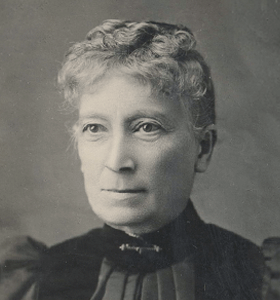
1. The First Principal Mary F. Scranton
1. The First Principal : Mary F. Scranton (1886.05 ~ 1890.05)
Mary F. Scranton was an American missionary who came to Korea in 1885. She was the first missionary sent to Korea by the Woman’s Foreign Missionary Society (WFMS) of the Methodist Episcopal Church. The next year, she opened the country’s first school for women with a single student. This was the beginning of women’s education in Korea.
As the founder and inaugural principal of Ewha Haktang, Mary Scranton mostly focused on providing education and medical services. Due to Confucianism, women in Korea had been taught to avoid male doctors. Girls were also often denied an education due to social conventions. To address these issues, Mary Scranton founded a school for Korean girls and opened a professional medical clinic exclusively for women in 1887. This hospital, the first one in Korea to exclusively serve women, opened on the Jeong-dong campus and would eventually be named Bogoonyogoan.
Ms. Scranton served as the head of Ewha Haktang for approximately five years. Though, as an educator, Mary Scranton drew heavily from Western styles of learning, she rejected the notion that the students in Korea should conform fully to foreign methods or ideals. “We would emphasize,” she summarized, “as has always been done in the past, that our school is, first of all, a school to make Korean girls better Korean girls.”
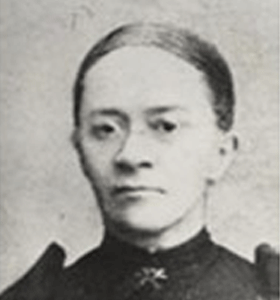
2. The Second Principal Louisa C. Rothweiler
2. The Second Principal : Louisa C. Rothweiler (1890.05 ~ 1892.06)
Louisa C. Rothweiler, an experienced missionary teacher, served as the second principal of Ewha Haktang following Mary F. Scranton. At this time, the school began to establish its curriculum and administration system. Academic subjects were formally categorized to raise the standard of education and school regulations were reinforced. These changes allowed the students to participate in the modern academic disciplines of geography, mathematics, science, English reading and grammar. As the student population grew, strict distinctions were made between classes and dormitory routines, adding structure and discipline to school life.
Principal Rothweiler was clear in the educational vision she had for Ewha, that the school philosophy was aiming towards “making Koreans better Koreans,” not turning Koreans into foreigners. She worked to teach Korean women and girls how to use their new knowledge to improve their lives as individuals and also to improve Korea.
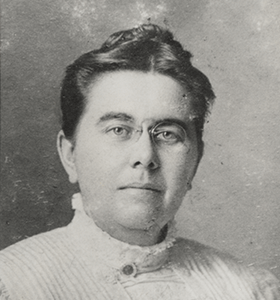
3. The Third Principal Josephine O. Paine
3. The Third Principal : Josephine O. Paine (1892.09 ~ 1907.06)
Josephine O. Paine served as the third principal of Ewha from 1892 to 1907, during which time the school developed rapidly. Beginning around 1900, Ewha began using textbooks that were specially written or translated by the teachers who were teaching them. It was far ahead of what was provided by the Korean government. Moreover, these textbooks provided global perspectives since they were adapted directly from American textbooks.
In 1904, Ewha had established its first official government-approved school system, a four-year middle school, and had grown to include more that ninety students. Furthermore, a new building, Main Hall, was built to accommodate the growing student body.

4. The Fourth Principal Lulu E. Frey
4. The Fourth Principal : Lulu E. Frey (1907 ~ 1921.04)
Ewha’s fourth principal, Lulu E. Frey, envisioned the establishment of an institution offering higher education for women. A high school was officially established in 1908, and the college at Ewha Haktang, which made higher education available to Korean women, was established two years later, in 1910. Principal Frey was very determined to confront the issue of higher education for Korean women. Her ambitious plan for a women’s college was met with protest from Koreans and colleagues alike, who considered such an establishment futile. It was only through her firm determination that Ewha College opened its doors to fifteen women in the same year that Korea was annexed by Japan.
In 1914, a kindergarten was established, thereby providing Korean girls and women with a complete, kindergarten-to-college education. In the following year, the kindergarten training school was established, marking the beginning of professional education for teachers at Ewha. Frey recruited more qualified teachers from Korea and the United States for the growing school. She also started a project to erect another building in order to accommodate all of the new students enrolling at Ewha. Finally, Simpson Hall was custom built in 1915.
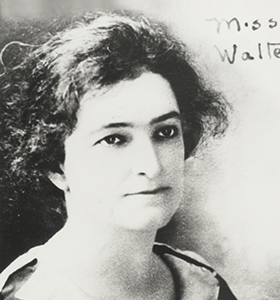
5. The Fifth Principal A. Jeannette Walter
5. The Fifth Principal : A. Jeannette Walter (1921-1922)
Althea Jeannette Walter came to Ewha as a professor at the college in 1911. Principal Walter dedicated a significant amount of time to physical education, which helped improve the general health and immune systems of the students. She also taught mathematics and Western history. She sympathized with the fact that the traditional Korean dress hanbok was not suitable for physically active and energetic movement, so she replaced the outfits of the students with more comfortable attire. The new design, comprising a longer shirt and a reformed skirt with a vest attached, greatly increased students’ level of activity and improved their physical health.
Though Principal Walter became the fifth principal of Ewha Haktang in 1921, she resigned from the presidency voluntarily the following year as she believed that the position of school principal was better suited to Alice R. Appenzeller, who returned to Ewha in 1922 after a sabbatical. During the construction of Frey Hall, the first building at the college, Principal Walter was in charge of interior design and onsite supervision. Even after returning to America, Ms. Walter continued to make contributions to Ewha, helping with school administration and fundraising through Friends of Ewha, which was a semi-official club organized by three missionaries who had served at Ewha :Althea Jeannette Walter, Harriette Palmer Morris, and Marion Lane Conrow.
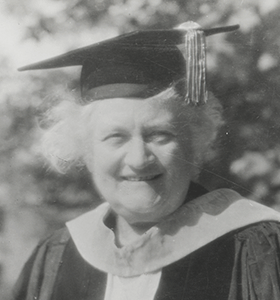
6. The Sixth Principal Alice R. Appenzeller
6. The Sixth Principal : Alice R. Appenzeller (1922.10 ~ 1939.04)
Alice R. Appenzeller, the daughter of the missionary couple Rev. and Mrs. Henry Appenzeller, was born in Korea. She would eventually become the sixth principal of Ewha.
In 1925, she reorganized the College and the College Preparatory Program at Ewha Haktang into a single entity named Ewha College. Under her administration the college received the government accreditation as a professional school, offering specialized education in several different disciplines. Ewha continued to expand with the establishment of three college departments :The Literary Department and Music Department in 1925, then the Home Economics Department in 1929.
Principal Apenzeller, who worked tirelessly to develop Ewha from a professional school to a university, died of a cerebral hemorrhage on February 20, 1950, while leading the Chapel service. To honor her service and dedication, representatives of Korean social groups paid their respects at her funeral service at the Jeongdong First Methodist Church.
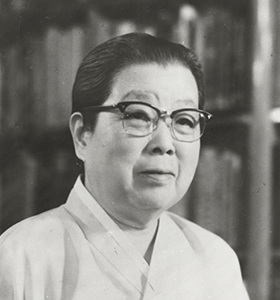
7. The Seventh President Helen Kim
7. The Seventh President : Helen Kim (1939.04 ~ 1961.09)
Helen Kim, the first Korean woman to earn a doctorate degree became the seventh principal of Ewha College in 1939. She became the first president of Ewha Womans University. The inauguration of Helen Kim was a major turning point that publicly declared Ewha’s determination to pursue independence and continuous, dynamic progress.
In 1946, Ewha Womans University became the first 4-year comprehensive university in Korea to be officially accredited by the Korean government. As an accredited university, Ewha revised its status and upgraded its curriculum. Most notable was the establishment of the graduate school in 1950, which reaffirmed Ewha’s position as a research university and a source for Korea’s foremost female leaders.
Helen Kim, who served for 22 years as the first Korean President of Ewha, led the growth and development of Ewha in terms of quantity and quality despite historical upheavals such as the U.S. military government, the division of South and North Korea, the Korean War, the April 19 Revolution, and the May 16 coup d’etat.

8. The Eighth President Kim Ok gill
8. The Eighth President : Kim Ok gill (1961.10 ~ 1979.08)
Kim Ok gill served as the eighth President of Ewha Womans University, from 1961 to 1979. During her presidency, she worked to establish Ewha as the leader in women’s education in Korea and as a truly global educational institution. She is remembered for expanding the student body and school facilities, as well as introducing an international exchange program that has enlightened foreigners on Korean culture and on the spirit of Ewha.
During her presidency, she emphasized the expansion of Ewha’s education into international circles and the joint research by women in Asia, with the aim of revolutionizing the lives of women as citizens of the world, as the new roles of Ewha did. In an effort to achieve this goal, the 1st General Meeting of Christian Women’s Universities of Asia was held at Ewha in 1972. Also, Ewha dispatched three missionaries to Pakistan for the first time in 1961.
Ewha launched the Experimental University program, which allowed students to start university without declaring their major until the end of their freshmen or sophomore year, as an opportunity to seek institutional readjustment and strengthen students’ autonomy to establish a new academic tradition. Although the Experimental University program was eventually abolished, it was an innovative attempt at seeking a more effective university system. In 1977, Ewha held the first lecture on women's studies in Asia to provide a framework for awareness of women's issues in Korean society, and to promote the personalization of women around the world as well as the realization of an equal society.
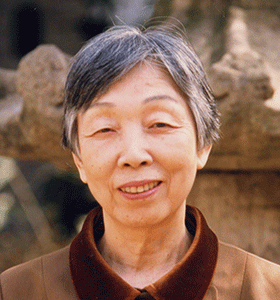
9. The Ninth President Chung Ii-sook
9. The Ninth President : Chung Ii-sook (1979.09 ~ 1990.08)
Chung li-sook, the ninth president, led Ewha to a broader, brighter future under the vision of the “University as Center of Education and Research” based on the spirit of Christianity. She strived to adapt to changing times by initiating new developments while leading Ewha into its second century with the commemoration of the 100th anniversary of Ewha’s foundation (1986).
President Chung wanted to nurture Ewha each student to become a professional with a sense of faith and history, an educated woman, and, by extension, an intellectual who realizes the essence of Ewha's ideology, thinking of the people and the world. In addition to stabilizing university finances by introducing modern management techniques, efforts were made to improve educational conditions and establish a research-based university under her guidance.
President Chung emphasized the value of academic research as the most important aspect, which improved the educational and research environment at Ewha dramatically. During her tenure, she made extensive contributions to the internalization of education and the promotion of science education by building basic science institutes, the Ewha Centennial Library, the Science Building, the Law Building, and much more. In addition, the School of Continuing Education was established in 1984 to provide opportunities for lifelong education for women, and attempts to improve the administration system continued.

10. The Tenth President Yoon Hoo Jung
10. The Tenth President : Yoon Hoo Jung (1990.09 ~ 1996.08)
Yoon Hoo Jung, the first female constitutional scholar in Korea and the first elected President of Ewha, established Ewha’s Twenty-first Century Development Plan (CDP) to make Ewha more of an international and information-, scientific-, and welfare-oriented institution.
She drafted and promoted the 100 Challenges of the CDP to set goals for improving Ewha’s international competitiveness. In particular, she established Korea’s best and the World’s first College of Engineering for women in 1996 to support women of scientific talent, widely perceived to be an essential human resource for the twenty-first century. Moreover, the CDP was devised to improve the quality of education and professors’ researching and teaching abilities. To that end, Ewha designed programs to entice eminent local and foreign exchange- and guest professors. Furthermore, special graduate schools, which included professional graduate schools, were established.
She emphasized the importance of cultivating professional women capable of competing internationally, defining the new Ewha archetype as the integrated woman. Academically, she emphasized woman focused study programs at Ewha and enabled women’s issues to take root as a field of academic study by establishing the Asian Center for Women’s studies and the Korean Association of Women’s Studies.
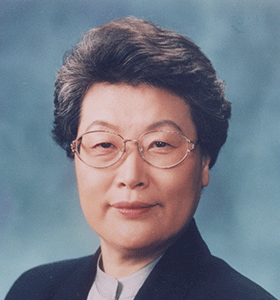
11. The Eleventh President Chang Sang
11. The Eleventh President : Chang Sang (1996.09 ~ 2002.07)
The 11th President, Chang Sang, set the goal of globalizing Ewha education and focused on producing talented female professionals who would be international competitive and make Ewha one of the world's most prestigious universities.
President Chang diversified the choice of majors by strengthening the undergraduate divisional system. She also established the educational system to encourage Ewha students with foreign language skills, information service skills and leadership through the advancement of the educational environment, information service, and enhancement of cooperation among academia, industries, and research institutes.
Ewha’s initiative to grow as a specialized research university for women was accelerated by the establishment of professional and specialized graduate schools, and the Center for Cell Signaling Research (CCSR) was established in 1998.

12. The Twelfth President Shin In-ryung
12. The Twelfth President : Shin In-ryung (2002.08 ~ 2006.07)
The 12th president, Shin In-ryung, set Ewha’s top priority as focusing on each student to foster a dynamic female leader who can lead an era of reconciliation and cooperation and advance the idea of unification. During her presidency, research infrastructure and learning environments were drastically improved to internalize the quality of education corresponding to the quantitative growth of the schools of Ewha.
In order to establish a future-oriented system of higher education, she implemented structural reforms and established new professional graduate schools such as the Graduate School of Medicine and the Graduate School of Business to lay a foundation for fostering global professionals. Molecular life sciences, nanoscience, women's studies, and international studies were specially implemented as strategies for characterization through selection and concentration. In addition, the Career Development Center for guiding the career path of students and graduates and Ewha Institute for Leadership Development for the service of strengthening social leadership of women were established.
In 2006, Ewha launched the Ewha Global Partnership Program (EGPP), a generous scholarship program supporting qualified female students from developing countries around the world, celebrating Ewha’s 120th anniversary. EGPP provides a full scholarship and stipends to selected students to study at Ewha College and graduate schools, nurturing their potential to become professional and global leaders.
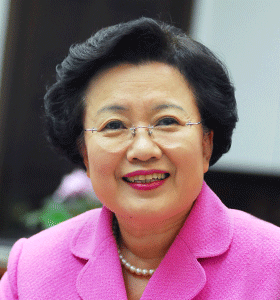
13. The Thirteenth President Lee Bae Yong
13. The Thirteenth President : Lee Bae Yong (2006.08 ~ 2010.07)
The 13th President, Lee Bae-yong, presented Initiative Ewha as the new vision, which emphasizes the leading role of Ewha in all areas of the 21st century, and pushed for the Global 2010 Project to establish campus networks in New York, Beijing and Paris. The Office of International Affairs was established to provide a foundation to enhance the global status of Ewha.
President Lee focused on raising the status of Ewha as a global center for education and research by opening the Ewha Academy for Advanced Studies and inviting distinguished scholars from Korea and abroad. Ewha also launched the Scranton Honors Program, which is Korea's first open-major program named after Ewha Haktang’s founder Mary F. Scranton. Through this program, Ewha laid the foundation to nurturing convergent talent that has crossed academic boundaries. In addition, Ewha opened a master's degree program called Ewha-KOICA Master’s Program to train female civil servants in developing countries as leaders who can contribute to their development and international cooperation.
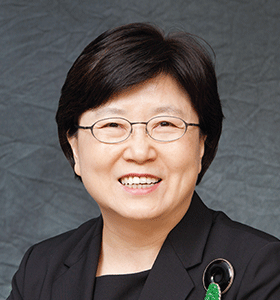
14. The Fourteenth President Kim Sunuk
14. The Fourteenth President : Kim Sunuk (2010.08 ~ 2014.07)
The 14th President, Kim Sunuk, focused on ensuring easy access to education by maximizing the capacity of the Ewha community and establishing a female-friendly educational environment under the vision of A Global Hub for Women's Education.
President Kim made every effort to strengthen the university’s research output and industry cooperation by implementing the Ewha Global Top 5 Project to foster world-class research groups and signing an industry-academic cooperation agreement with the global chemical corporation Solvay to build the Ewha-Solvay Global R&D Center. In 2014, Ewha opened the University-Industry Cooperation Building with the aim of providing infrastructure for a global research network that will lead the future of science and promote cooperation among academia, industries, research institutes, and government agencies.
During the presidency of President Kim, Ewha opened the Global Service Center to attract and manage international and foreign students, and established the EGEP (Ewha Global Empowerment Program) aimed at enhancing women's human rights in non-governmental Asian and African public sectors by focusing on strengthening the capabilities of participants. In addition, the construction of a new dormitory was commenced to provide students with a stable learning environment without the burden of housing expenses. Furthermore, the Ewha Welcome Center, Korea’s first global university information center was opened in 2013.

15. The Fifteenth President Choi Kyung-hee
15. The Fifteenth President : Choi Kyung-hee (2014.08 ~ 2016.10)
The 15th President, Choi Kyung-hee, proposed the vision “Innovation Ewha” with the goal of becoming one of the top 100 universities in the world.
President Choi reorganized the academic system by establishing the HOKMA College of general education and the College of Science & Industry Convergence to prepare students for future industrial trends and to help students become creative and convergent thinkers. She also prepared the foundation for the launch of the ELTEC College of Engineering.
In addition, the Ewha-JAX International Research Center for Cancer Immunotherapy was established, the new dormitory, E-House, was built, and the construction of a new hospital in Magok district of Seoul was begun.
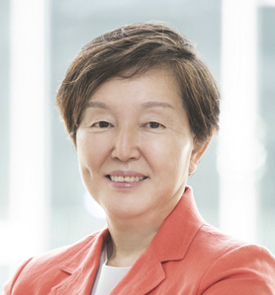
16. The Sixteenth President Kim Heisook
16. The Sixteenth President : Kim Heisook (2017.05 ~ 2021.02)
Kim Heisook was elected as the sixteenth President through a direct election in which every member of Ewha was able to participate for the first time in Ewha history.
Under the vision of “Women intellectuals pioneering the future”, Kim established the core strategies of three Es (Empowerment, Engagement, and Exploration), focusing on “capability-building based on academic autonomy”; “pursuit of community ethics based on communication and trust”; and “leading university education with a challenging spirit.”
Entering into the era of the Fourth Industrial Revolution, President Kim promoted the decentralization of colleges to enhance Ewha’s flexibility and capability and focused on creating an optimal environment for convergence research and strengthening Ewha’s research capacity with the completion of Ewha Research Cooperation Building. In addition, Kim presented a new model of university education based on Ewha’s unique spirit of challenge, including the integrated selection of incoming students for each division as part of the regular admissions process for the first time among major universities, and introducing the Independent Faculty Assessment system. Carrying the torch for Ewha’s mission of fostering talents who can contribute to the society and community, she dedicated herself to realizing the school’s core value of pursuing community ethics based on communication and trust in order to pioneer the future society.

17. The Seventeenth President Kim Eun Mee
The 17th President :Eun Mee Kim (Mar. 2021 – Jan. 2025)
During her tenure, Eun Mee Kim, the 17th President of Ewha, was instrumental in furthering Ewha’s mission to lead meaningful changes in society.
Guided by the vision of “A Creative and Innovative Platform Leading to a Sustainable Society,” she fostered a vibrant research ecosystem, established an educational innovation platform to address the challenges of digital transformation, and implemented key initiatives to support students’ future development and enhance the campus environment.
Under the leadership of President Kim, the implementation of the Ewha Frontier 10-10 Project marked a major milestone in advancing the university’s transformation into a research-intensive institution. She also spearheaded the establishment of the College of Artificial Intelligence and the Ewha Graduate School of Data Science to cultivate women leaders who are prepared to lead the Fourth Industrial Revolution era.
In addition to receiving an S grade in the 2024 University Innovation Support Project Evaluation, Ewha achieved a graduate school enrollment rate of 94.6 percent in 2023, reflecting the tangible outcomes of its efforts to establish itself as a research-intensive university.
During the global spread of COVID-19, President Kim led the implementation of a proactive quarantine system known as the Ewha Safe Station to ensure a secure educational environment, while simultaneously advancing campus infrastructure—including ICT capabilities—to pioneer next-generation hybrid learning and overseeing the renovation and dedication of Hak-gwan. In addition, President Kim advanced the internationalization of education at Ewha and strengthened the university’s global brand by launching the Global Scholars Program within the HOKMA College of General Education, a new initiative designed for international students.
Looking ahead to Ewha’s 150th anniversary, President Kim initiated the Ewha History Compilation Project and led major campus development efforts, including the transformation of Helen Hall into the Ewha Advanced Library and the renovation of the Human Ecology Building into the Ewha West Campus. These projects served to reorganize and preserve Ewha’s historical and spatial records, while presenting a renewed vision for its future. Demonstrating global leadership, President Kim also promoted sustainability through international collaboration and remained committed to engaging with local communities and supporting underrepresented and underserved populations.
Education
- 1981B.A. in Sociology, Ewha Womans University
- 1983M.A. in Sociology, Brown University, USA
- 1987Ph.D. in Sociology, Brown University, USA
Career
- September 10, 1958Born in Daegu, Korea
- 1984Recipient, STEP Award, American Sociological Association, USA
- January 1987-August 1997 Professor, Department of Sociology, University of Southern California, USA
- September 1997- February 2024Professor, Graduate School of International Studies (GSIS), Ewha Womans University
- 2001-2019Dean, International Education Institute, Ewha Womans University (August 2001-January 2005)
Dean, Graduate School of International Studies, Ewha Womans University (February 2005-January 2007; February 2011-April 2017)
Director, Institute for Development and Human Security, Ewha Womans University (September 2007-July 2019)
Dean, The Graduate School, Ewha Womans University (August 2017-July 2019) - 2002Recipient, Award for Contribution to International Exchange and Education, Ministry of Education and Human Resources Development
- 2006-2012Member, Official Development Assistance (ODA) Korea, under the Prime Minister’s Secretariat
- 2006-PresentPolicy Advisor, Ministry of Foreign Affairs (2006-2008; 2010-2018) Member, Sustainable Development Committee, Ministry of Environment (2021-Present) Policy Advisor, Ministry of Gender Equality and Family (2010-2013; 2016-2017; 2018-2019)
- 2008-2010 Member, Presidential Regulatory Reform Committee
- 2012Recipient, Service Merit Medal, Korea
- 2013-2016 Secured and led three consecutive research projects funded by the Bill & Melinda Gates Foundation—the first grant of its kind awarded to a Korean university
- 2013-PresentAdvisory Committee Member, Korea International Cooperation Agency (KOICA) (2013-2017, 2021-Present)
- 2017-2019 Member, Independent Group of Scientists for the UN Global Sustainable Development Report
- 2019-PresentHonorary Professor, International Institute of Korean Studies, University of Central Lancashire, UK
- 2019-PresentBoard Member, Hansol Culture Foundation
- 2021Recipient, Chang-Lin Tien Distinguished Leadership Award, The Asia Foundation
- March 2021-January 202517th President, Ewha Womans University
- May 2021-May 2024Vice Chairperson, Korean National Commission for UNESCO
- December 2021-December 2022Co-Chair, Committee for the Formulation of the Fifth Science and Technology Master Plan, Ministry of Science and ICT
- 2023Recipient, Building Bridges Award, awarded to Ewha Womans University by the Pacific Century Institute상
- January 2024-PresentFirst UN Women Goodwill Ambassador from Korea

